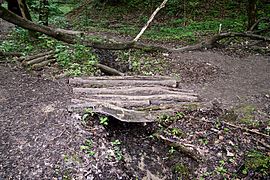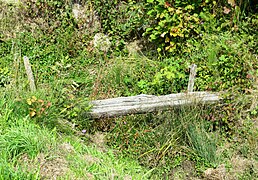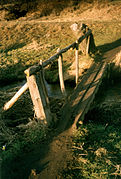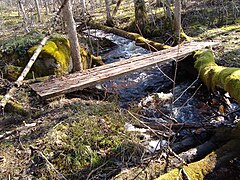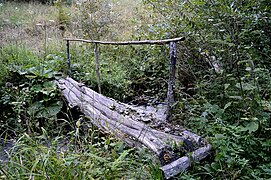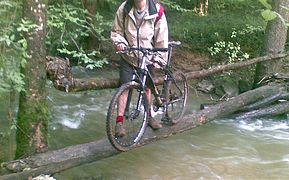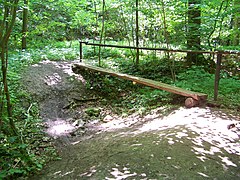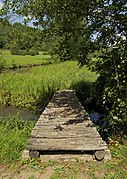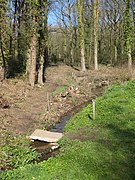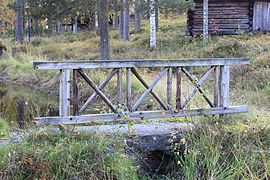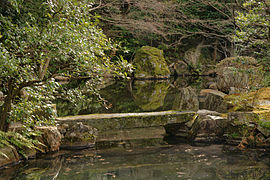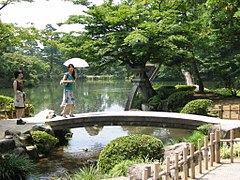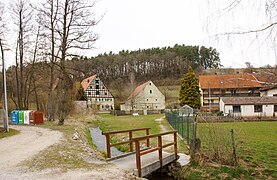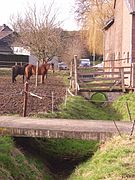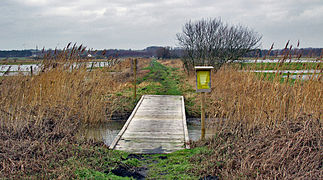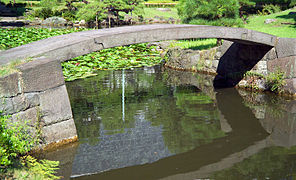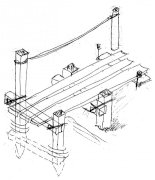Spang
Hopp til navigering
Hopp til søk
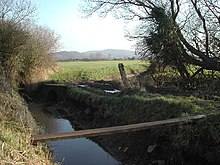

English: This gallery is for "rudimentary" small and simple bridges (special terms exist in some languages, but apparently there's no unambiguous English term). A partly related English term is log bridge (but it excludes small bridges not built of logs, and includes also larger/wider log bridges for vehicle use).
Català: Palanca o pont rudimentari
Dansk: Spang, enklest mulige bro
Deutsch: Steg, eine einfache kleine (schmale) Brücke, die meistens nur für Fußgänger gedacht ist (eventuell auch für Fahrradfahrer oder Tiere) und aus verschiedenen Materialien bestehen kann (Holz, Stein, Beton…)
Español: Pasarela o puente rudimentario
Norsk bokmål: Klopp
Svenska: Spång, en mycket enkel bro
Definition[rediger]
English: In principle, the colloquial "small and simple bridge" terms of different languages are used similarly, although not consistently to the last detail. It very much depends on regional/cultural/historical/etc. backgrounds, how large, long or wide a bridge can be, to still be denoted as "small and simple". However, there are a few suitable criteria to narrow down the core which all these terms have in common (see also borderline cases):
- Such a bridge is rather narrow and short. (common interpretation: If it is longer, it needs to be narrow. If it is wider, it needs to be short.)
- Such a bridge is usually built for pedestrians only (footbridge), but it may also be used by cyclists, or animals, etc.
- Such a bridge can be made of various materials (wood, bamboo, stone, concrete…, or even metal like discarded railway tracks).
- Such a bridge has only one relevant structural element (e.g. one wooden plank, or a slab of concrete), or it consists of only a small number of main structural components (e.g. two parallel logs).
- The load-bearing structural element/s rest/s in position only by its/their own weight (e.g. on the banks of a stream). Further fixation, if existing, is secondary. Such bridges can usually be classified as simply supported single-span beam bridges.
- Constructed abutments at both ends of a bridge span often don't exist at all. If existing, they are not elaborately constructed, but only of simple design (rammed earth, in-situ rocks, parts of trees, rough concrete blocks, etc.).
- Additional elements like handrails may be present, and a bridge may feature e.g. smaller boards added on top, to provide a more even surface. But such characteristics are always secondary.
Small and simple bridges by material[rediger]
Wood as material[rediger]
Bamboo as material[rediger]
Stone as material[rediger]
Concrete as material[rediger]
Metal as material[rediger]
Unidentified, or combined material[rediger]
-
wood or concrete?
-
wood, stone or concrete?
-
stone or concrete?
-
wood or concrete?
-
steel and wood
Borderline cases[rediger]
English: The following images should illustrate the language-dependent limits of the above definition. In some languages one or more of these bridges might still be called "small and simple", in others not.
-
bridge extended into a boardwalk, combined construction
-
steel and wood, solid construction might be called "too complex"
-
might be called "too wide" (note the vehicle tracks in the background)
-
multiple-span elements, might be called "too long"; besides: rather a boardwalk than a bridge (note the almost continous soil/vegetation contact)
-
ladder-shaped "bridge", not that easy to cross
-
rather a (collapsed? or) simple floating bridge with some "hidden" supporting elements, e.g. wooden blocks or stones
-
decorative zig-zag bridge in a Japanese garden, multiple elements
-
stone bridge in a Japanese garden, "too complex" due to elaborately constructed abutments
-
simple bridge as part of a sluice (technical parts dominate bridge function)
-
looks like a bridge, but is rather a small dam with two culverts (note the pipes)

